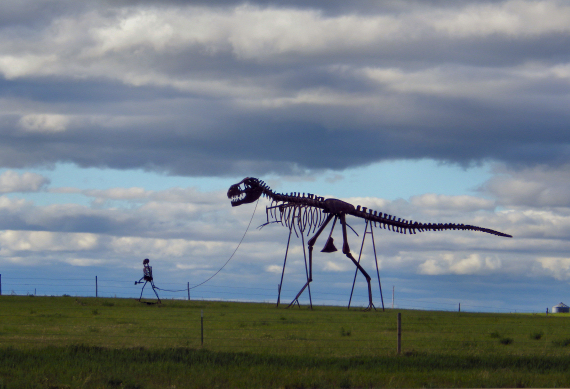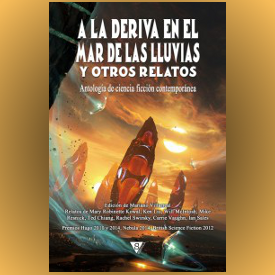
It’s been about a year since I published a review—a positive one—for the book Extreme Dentistry, by Hugh A.D. Spencer. Well, the Toronto writer is back with a collection of thirteen short stories called Why I Hunt Flying Saucers and Other Fantasticals (Figure 3). I really enjoyed the way Hugh mixed his Mormon background with dentistry and other things in that particular book, so I was looking forward to this one with anticipation. As a person who’s better—so far—at writing short stories than novels myself, I enjoy seeing how others handle the short form. (In my less-than-humble opinion, it is fairly easy to write a short story, but very hard to write a good one.) And Hugh handles the form very well indeed. All of these have been previously published, most in On Spec or Tesseracts, and it’s easy to see why his writing has impressed editors.
The thirteen stories are, in order:

Why I Hunt Flying Saucers
Icarus Down/Bear Rising
The Triage Conference
The Robot Reality Check
Strategic Dog Patterning
The Z-Burger Simulations
Mormonism and the Saskatoon Space Programme
Pornzilla
The Hospital for Sick Robots
Problem Project
A 21st Century Scientific Romance
When Bloomsbury Fails
(Coping with) Norm Deviation

Hugh starts the anthology off nicely, with a little tale (“Why I Hunt Flying Saucers”) about a poor schmuck who is constantly being “encountered” by aliens—“close encounters,” that is, of the first, second and third kinds. They camp in his bathtub, they abduct him for that uncomfortable probe (you know where), they steal socks from his dryer. But there is hope at the Reference Library. Hugh also manages to sneak in another Mormon reference; I hope you laugh at this one as much as I did!
Icarus Down/Bear Rising is that unusual thing, a purely Canadian SF story. Well, it’s not all SF; there’s a mystical component to it. For those of you in the Lower 48, who want to know what a Canadian SF story is, there are as many definitions as there are definitions of SF (or even of “sci-fi”!). It’s somewhat related to the Native Indians in the story (whom we up here call “First Nations”—they were here first, and had their own well-defined “nations”); it also sometimes has to do with the so-called “Two Solitudes” (but not in this case; this story has nothing to do with Anglophones vs. Francophones); it’s more an attitude. The Canadian character is very different on the whole from the American character; and would take far more space than I have here—and maybe some deeper thought than I can muster in one column—to define. The story involves worldviews; whose is correct? In its own way, it’s a powerful tale.
“The Triage Conference,” I suspect, may involve some wish fulfillment for Hugh, as an anthropologist. (He has completed graduate studies at the University of Toronto and McMaster University in anthropology; apparently his studies involved “anthropological studies into the origins of religious movements in science fiction fandom”—one imagines him comparing Wiccans and followers of Cthulhu in academic papers.) It’s all about a conference of the sorts of people who are always deciding who the world would be better off without—and it’s never them! A fun, but slightly nasty (or more like it, pointed) romp.
“The Robot Reality Check” owes a lot to Isaac Asimov, and Hugh acknowledges that in his foreword to the story (by the way, all these stories have interesting forewords. Be sure to read those as well!) You know Asimov’s “Three Laws”? Well, in this story they undergo some slight revision: “The Real Laws of Robotics – Number One: A robot will always break down just after its warranty period has expired.” Yep, reality and SF collide—and reality will always win.
“Strategic Dog Patterning” is a chilling look at evolutionary (and sociological) adaptation. Supposing evolution happened in real time, rather than near-geological time? Would that work to our (human) advantage? Maybe not….
“The Z-Burger Simulations” involves the combination of religion and fast-food sector jobs. At one point, Hugh worked at an A&W for a short period, and that might have influenced this story somewhat. Combine that experience with “The Church of Business,” and away you go! Would you like fries with that?
“Mormonism and the Saskatoon Space Programme” is also very Canadian, but partly because it name-drops a lot of Canadian locations. It has to do with actual space travel and the Church of Jesus Christ of Latter-Day Saints (which I believe is the actual name of the Mormon Church). Another thing Hugh likes to do, which shows up somewhat in this story, is to “Phil Dick” with us. If you’re familiar with the writings of the late Philip K. Dick (as opposed to the movies made from those writings), you’ll know that Dick was very fond of playing with the reader’s head—sometimes you just weren’t sure exactly what was reality and what wasn’t. I think there’s a touch of Phil Dick here… but I’m not sure. Kinda fun nonetheless.
I don’t want to describe the whole book to you here—what would be the fun in that? As you probably know, I’m not fond of spoilers, and I think telling you, even in as little detail as I have here, might deprive you of a bit of the fun of discovery. All I will tell you is that you will enjoy the rest of them; keep an eye out for “The Hospital for Sick Robots”; that’s a deep one. But I didn’t find a clunker in the bunch in this book. I recommend it; it will be available from the usual (Amazon, etc.) in April.

And now we come to something I liked a lot less, which was the second installment of the eight-part Hulu adaptation of Stephen King’s 11/22/63, here called 11.22.63 (the dots are important, so they can do a little “laser sight” thingy with the last period in the opening graphic). But before I tell you what I disliked about this episode, let me tell you how I felt about the book itself. I first read the book (hardcover) when it came out, and I liked it, but it didn’t make that much of an impression on me. But when I found out Hulu was adapting it to an eight-part TV series, I figured I’d have to reread it, and I’m almost finished. I liked this book a whole lot better the second time around; in fact, the writing is extremely good. King is a master at setting his characters in a specific time and place and, while he may not have the descriptive powers over locale that—for example—James Lee Burke has, this book drags you willy-nilly into 1958 and places like Derry, Maine and Fort Worth, Texas. That’s a big thing, because the better a book is written, and the more you are pulled into it, the more important the characters and locales become to the reader.
If you will recall, I said last week that (and if I didn’t, I should have) that no book can survive a translation to screen intact—and probably no book should. The two media are completely different; in a book you can be put into the mind of a character, directly—that’s seldom possible in a film or TV series without a clunky device like first-person narration. So I could accept that the filmmakers would have to “speed up” the past times (if for no other reason that from September 1958 to November 1963 is five years, and that’s a lot of screen time); I could accept that they changed the “past” from 1958 to 1960. That difference is negligible. There are other changes that don’t impact the thrust of the book so much, and I can accept those. But when the filmmakers say, as Bridget Carpenter said in Variety, “You have to make that dramatic, you have to make it drive like a train. We wanted a speeding train of a story,” Carpenter adds, explaining that the pacing is different from the book. But other than that, ‘11.22.63,’ which launches on Presidents Day, will stay “very true” to King’s masterpiece.” (emphasis mine)
Well, one of the things that happened in the book was that Jake Epping (a schoolteacher who taught adult education classes as well as his regular classes) found out about a tragedy involving one of his adult education students, a janitor. When Harry, the janitor, was about ten, his father went on a rampage in Derry, Maine, and killed Harry’s mother, sister and brother (shades of The Shining!). Jake determined that he was going to correct that when he went back in time. There was little interaction between Jake and Harry’s family in the book, but (speaking of Easter eggs!) Jake does briefly meet Richie Tozier and Beverly Marsh from IT! while in Derry. That never happens in the show; instead, the action is moved from Maine to Kentucky, and there are whole scenes made up out of whole cloth involving Jake’s interactions with Harry’s father and mother and the rest of the family. Why? Why change all that? Why do the screenwriters (and director/producer) think they know better than King how to write those interactions? I wouldn’t rail about that except for the “…will stay very true to King’s masterpiece” quoted above. If you know the book, this is bound to make you mad, as it did me.
Other than that, the episode went all right; although it was completely different from the book, I suppose it accomplished the aim of keeping Harry’s family alive, but it introduced a brand-new character who wasn’t in the original book. Colour me confused. And a bit ticked off. We’ll see how it goes in the next episode.
Coincidentally, a bit of information on the Kennedy assassination popped up when I went searching for the new season of the American Antiques Roadshow (season 20). In episode two, filmed in Spokane, a woman—Sue Mortensen—who had been a John F. Kennedy staffer during his brief presidency, brought a number of documents and photographs from her years with Kennedy to be evaluated. When the expert asked her about the day (11/22/63, as I’m sure you remember) Kennedy died, she told about leaving Air Force One so the Johnsons could go back to Washington on it with their own staff. She took the “backup plane” back to Washington, and on it were a number of people from the Texan delegation. She reported that some of them seemed very happy about Kennedy’s death. The comments on PBS.org about her statement were very telling: one person said that her comment about the Texas delegation seemingly “happy” after the tragic event that had just occurred was an insult to the state of Texas and to Lyndon Johnson, and that no one was happy that horrible day. The very next person said that the commenter was “in 5th grade in East Texas that day and the whole class (except me) cheered when the principal announced that President Kennedy had died. The teacher didn’t stop them.” Sort of sounds like, attitude wise, what’s happening with the current political race, doesn’t it? Extreme polarization, folks, doesn’t help anyone, in my opinion.

DEPARTMENT OF CALLING ALL HEINLEIN FANS! From Spider Robinson comes this: the current owner of the house Robert A. Heinlein grew up in, in Butler, Missouri, is getting ready to sell the house. He wants to give RAH fans the first shot at it. PLEASE! Serious enquiries only—don’t bug the guy unless you really can afford it and want to live in this house! (Butler, MO is a sleepy little burg that is the perfect embodiment, in my opinion, of small-town America, with a bandstand in front of the County Courthouse, and so on. I took the photo in Figure 5 on one of my recent trips to Missouri.) The Butler library is a private affair, but it has a Robert A. and Virginia Heinlein Wing, and is a pretty nice place. The librarian is pretty proud of it, too, and it has a lot of RAH memorabilia. How would you like to raise your kids in the house where Heinlein grew? Click the link if you would.

And finally, just because I can, this photo, which I took in Kansas, or Colorado, or South Dakota.
I’d appreciate your comments on this week’s column if you can. You can also comment on my Facebook page, or in the several Facebook groups where I publish a link to this column. I might not agree with your comments, but they’re all welcome—I love hearing what my readers say. Please don’t feel you have to agree with me to post a comment, either. I learn a lot from differing opinions. My opinion is, as always, my own, and doesn’t necessarily reflect the views of Amazing Stories or its owners, editors, publishers or other bloggers. See you next week!











I Googled it, and it’s a bit east of “1880s Town” in South Dakota, dinosaur lovers. (Near Murdo, SD, if you care. When we went to 1880s Town, Kevin Costner’s horse from “Dances With Wolves” was still alive. I may have even taken pictures of it.)